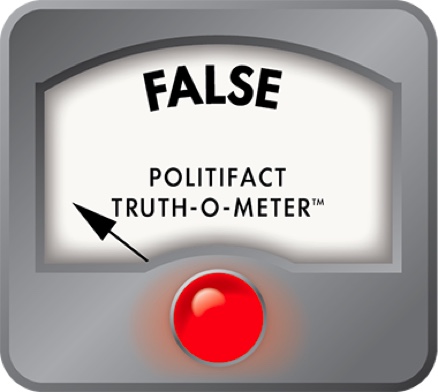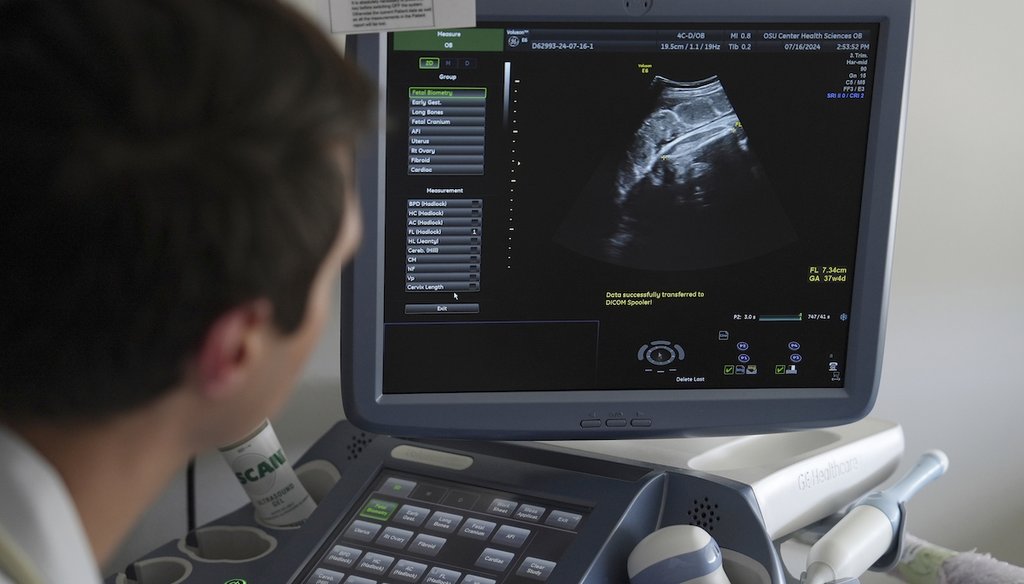

Our only agenda is to publish the truth so you can be an informed participant in democracy.
We need your help.


Dr. Jacob Lenz performs an ultrasound at the Oklahoma State University obstetrics and gynecology clinic in Tulsa, Okla., on July 16, 2024. (AP)
President Donald Trump issued an executive order defining the terms "male" and "female" based on whether a person belongs "at conception" to the sex that produces sperm or eggs.
Neither sperm nor eggs are produced at conception. Zygotes have only genetic information determining sex. After about six weeks, growing embryos begin to develop sex-specific structures.
Although scientists once theorized that all embryos start developing as females, recent research suggests that neither sex is "default." Legal experts told PolitiFact they see no basis for the claim that his order would "legally classify" everyone as female.
As part of a torrent of Day 1 executive orders, President Donald Trump declared it "the policy of the United States to recognize two sexes, male and female."
But the order’s definitions of "male" and "female" led some social media users to wonder whether Trump accidentally categorized all people as women:
"Under Trump's executive order, every single person in America is now legally classified as female," a Jan. 21 X post read. "All embryos begin by developing female sex organs, with male sex organs only replacing them at around 6 weeks of gestation."
But scientific research and conversations with legal experts showed this claim was off base.
Early fetal development is not as straightforward as the post described. But neither was the wording in Trump’s executive order. It said:
"(d) ‘Female’ means a person belonging, at conception, to the sex that produces the large reproductive cell.
"(e) ‘Male’ means a person belonging, at conception, to the sex that produces the small reproductive cell."
Conception is when a sperm successfully fertilizes an egg, forming a zygote. The single-cell zygote possesses genetic coding related to sex — typically XX (female) or XY (male) — but it cannot produce its own reproductive cells.
In the first few weeks, a growing embryo has growing gonads that haven’t developed into male or female reproductive structures yet. Around six weeks, genetic coding triggers the growing embryo to start developing testes or ovaries.
Although scientists once theorized that all embryos start developing as females, recent research has determined that neither sex is "default."
Scientists who considered the order said they were perplexed by its juxtaposing "at conception" alongside an aspect of sex differentiation that happens only after weeks of gestation. But legal experts were also leery of claims that interpreted the definition to mean all people would be "legally classified" as female.
A person’s "sex," according to scientists, is not easily measured by one factor. Chromosomes, gonads, hormones and genitalia can all contribute to a person’s sex categorization.
And those determinants are not all clear at conception. Nor do they always add up to typical male or typical female anatomy. Research estimates that about 1.7% of the population, for example, has intersex conditions or differences in sex development — cases in which someone’s anatomy does not neatly fit into male or female.
People born with Klinefelter Syndrome, for example, have XXY chromosomes and although they are typically assigned male at birth, their anatomy is often affected by the additional female chromosome. People with de la Chapelle syndrome have female chromosomes but can develop a penis and be assigned male at birth. People with androgen insensitivity syndrome have male chromosomes, but don’t respond to their body’s naturally produced male hormones. That means genetically a male fetus, with testes and normal testosterone production may develop a vagina and be assigned female at birth and raised as a girl.
Other conditions result in ambiguous genitalia that do not fall neatly into either sex category.
People with these conditions, therefore, are not accounted for under Trump’s order.
"A lot of other variations might be noticeable at birth if they cause other types of genital differences," said Sylvan Fraser Anthony, legal and policy director at Interact, a nonprofit advocating for intersex youth. "Others will be discovered, you know, not until later."
Sean Tipton, chief advocacy and policy officer for the American Society for Reproductive Medicine, said political efforts to place people "into two neat categories does not reflect biological reality."
"There are thousands of Americans whose chromosomes, external genitalia, and reproductive capacity do not match with some politician’s notion of how the world should be," Tipton said.
The assertion that "all embryos begin by developing female sex organs" is based on outdated science.
Scientists in the past theorized that female fetal development was the default pathway, stopped only by the activation of a Y chromosome gene that causes testes to develop.
But recent research suggests that neither path is "default" and the development of both testes and ovaries is complex. More recent research describes reproductive structures in the first few weeks as "bipotential," meaning they are not yet male or female.
Legal scholars also challenged the claim’s notion that Trump’s order would legally affect "every single person’s" sex.
"There is no such thing as a universal ‘legal’ gender," Rose Saxe, the American Civil Liberties Union’s LGBT & HIV Project’s deputy director, said.
State and federal governments’ understanding about a person’s sex and gender essentially depends on however official paperwork — birth certificates, driver’s licenses, passports — describes the person.
And Trump’s new definition of the sexes applies only to interpretation and enforcement of federal law and policy, not state laws. That could mean that people may no longer be able to change their gender markers — the "M" or "F" denoting male or female — on federal documents such as passports. But state IDs are governed by state laws, which may enable people in some states to get IDs that align with their gender identity.
How the Trump administration will enforce the order’s definition is also unclear: When federal employees submit paperwork for example, Saxe said, will they be asked, "‘Did you belong at conception to the sex that produces the large reproductive cell?’ Maybe that's what they're going to ask people, or are they just going to have a form that says male or female and ask people to check the box?"
And despite the definition’s wording, Saxe said, a court would be unlikely to adopt the interpretation that the law "classifies" everyone as female.
These definitions might be short-lived. Within 30 days, the order dictates, "the Secretary of Health and Human Services shall provide to the U.S. Government, external partners, and the public clear guidance expanding on the sex-based definitions set forth in this order."
State lawmakers have so far led the charge to define and redefine sex and gender, and Trump’s effort follows suit. Nine states have explicitly defined sex as binary according to the Movement Advancement Project, a nonprofit that tracks LGBTQ+ policy.
Like Trump’s order, nearly all states adopting laws to redefine sex and gender have added definitions that refer to reproductive aspects of sex, the ability to produce sperm and eggs, as the dividing line between the sexes rather than chromosomes or genitalia
But Trump’s order language is distinct from the state laws in its use of the phrase "belonging, at conception," a likely nod to anti-abortion rights advocates.
During a Jan. 24 March for Life event in Washington D.C., abortion rights opponents celebrated Trump’s inclusion of the phrase "at conception."
"I don’t know if you saw (Trump’s) executive order but it defines life as beginning at conceptions rather than birth," House Speaker Mike Johnson, R-La., told the crowd.
An X post said, "Under Trump's executive order, every single person in America is now legally classified as female."
Experts PolitiFact interviewed called the executive order’s definitions of what defines a male and a female as scientifically flawed and legally awkward. But no one believed the order’s language would lead the federal government to classify everyone in the U.S. as female.
We rate this claim False.
Interview with Rose Saxe, deputy director of the LGBT & HIV Project at the ACLU, Jan. 23, 2025
Interview with Sylvan Fraser Anthony, legal and policy director at Interact, Jan. 23, 2025
Email Interview with Sean Tipton, chief advocacy and policy officer for the American Society for Reproductive Medicine, Jan. 23, 2025
The White House, "Defending Women From Gender Ideology Extremism And Restoring Biological Truth To The Federal Government," Jan. 20, 2025
X post, archived, Jan. 21, 2024
Cleveland Clinic, "Conception: Fertilization, Process & When It Happens," Sept. 6, 2022
Science, "Elimination of the male reproductive tract in the female embryo is promoted by COUP-TFII in mice," Aug. 18, 2017
StatPearls, "Embryology, Sexual Development," Aug. 28, 2023
National Library of Medicine, "Sexual Differentiation," May 27, 2020
Best Practice & Research Clinical Obstetrics & Gynaecology, "Disorders of Sex Development," April 1, 2019
Centers for Disease Control and Prevention, "Terminology | Adolescent and School Health," Nov. 29, 2024
American Psychiatric Association, "Definitions of Gender, Sex, and Sexual Orientation and Pronoun Usage," Nov. 2017
ABC News, "Trump's definition of 'male,' 'female' criticized by medical and legal experts," Jan. 23, 2025
NBC News, "When is a person's sex determined? Trump has no conception, experts say," Jan. 27, 2025
Cleveland Clinic, "Klinefelter Syndrome: What It Is, Symptoms & Treatment," Oct. 9, 2023
Cureus, "A Case of de la Chapelle Syndrome," Nov. 2, 2023
Cleveland Clinic, "Androgen Insensitivity Syndrome: Complete & Partial," Dec. 14, 2021
National Libraries of Medicine, "Sex Begins in the Womb," 2001
Journal of Sex & Marital Therapy, "Some biology of sexuality," 1974
The Genetic Literacy Project, "Embryos aren’t female by ‘default’ after all, study shows," Sept. 21, 2017
PolitiFact, "What is ‘sex’? What is ‘gender’? How these terms changed and why states now want to define them," March 22, 2024
The Guardian, "Trump’s executive order on gender uses language pointing to ‘fetal personhood’," Jan. 23, 2025
Planned Parenthood, "Sex and Gender Identity," accessed Jan 27, 2025
Canadian Institutes of Health Research, "What is gender? What is sex?," May 8, 2023
Nature, "US proposal for defining gender has no basis in science," Oct. 30, 2018
United Nations, "Estimated 1.7 per cent of new-born babies are intersex," Nov. 12, 2016
Movement Advancement Project, "Regulating Gender to Allow Discrimination," accessed Jan. 28, 2024
Idaho Legislature, "House Bill No.421," 2024
Kansas Legislature, "Senate Bill 180," April 20, 2023
Louisiana Legislature, "ACT No. 436," 2024
Mississippi Legislature, "Senate Bill 2753," 2024
Montana Legislature, "SB 458," 2023
North Dakota Legislature, "House Bill No. 1474," Jan. 3, 2023
Oklahoma Legislature, "House Bill 1449," 2024
Tennessee Legislature, "SB1440," 2023
Utah Legislature, "HB 257," 2024
The 19th, "The State Department is blocking new passports for trans Americans," Jan. 28, 2025
Movement Advancement Project, "Identity Document Laws and Policies," accessed Jan. 28, 2025
Cleveland Clinic, "Disorders of Sexual Development (DSDs)," Jan. 22, 2024
In a world of wild talk and fake news, help us stand up for the facts.
